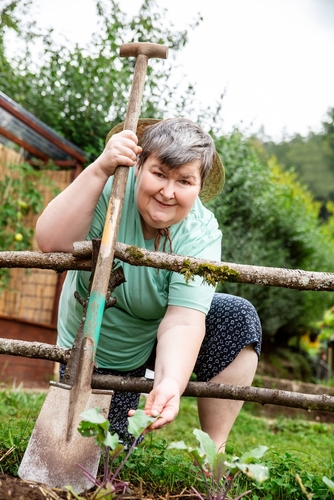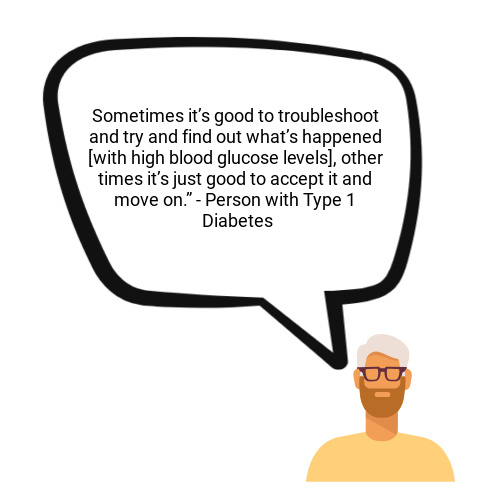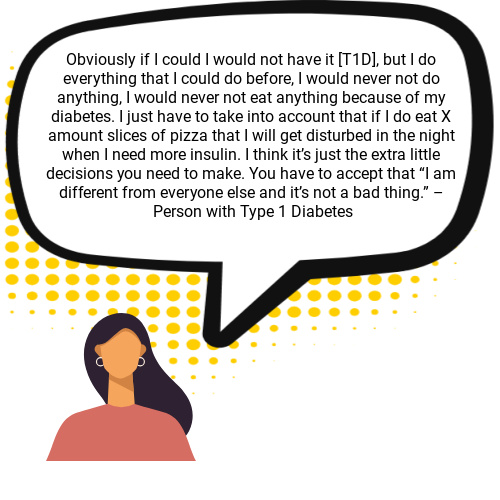
Learning to live with type 1 diabetes: adjustment and acceptance
If you think back to when you first started a new school, it’s likely that you did not know what to expect, how to manage school demands, or what was going to happen with other pupils or teachers, and that you wanted to blend in and do well.
Over time you gradually learned what was expected of you, how to cope with school work, which aspects of the guidelines were really important to stick with and where it was possible to be more flexible – it probably became less stressful and easier in terms of knowing where you were with it all. You may not have ever really liked school, but you probably reached a point of acceptance and learned strategies to cope with it.

You may experience, or have experienced, similar feelings in terms of beginning to accept living with Type 1 Diabetes. This is a process that takes time, and an attitude of acceptance can come and go a little at different times. We often refer to acceptance as the idea of coming to terms with the diagnosis. It ultimately means fully acknowledging that diabetes is part of your life and who you are (your identity) and “allowing” it to be there (given that there isn’t a choice to magically get rid of it, no matter what we do).
The huge plus side of developing an acceptant attitude towards diabetes means that energy that might have been used to either battle against diabetes or try and avoid thinking about it is now freed up to spend on the things that matter in life, things you enjoy.
Along the way, learning to accept day-to-day experiences is helpful


If you’re interested in thinking more about skills to help practice and develop an acceptant approach, take a look at the Helpful approaches worksheet.
Alongside acceptance, adjustments in life can be made to allow diabetes to sit more comfortably.
Going back to the analogy of needing to go to school, you might think of a few adjustments you can make so that school life is a bit less stressful. For example, you might invest in a sturdy rucksack, given that you’re now going to need to carry around a few heavy books – this will increase your comfort and keep everything safe and accessible. You might also start up a habit of walking to school rather than catching the bus, as you’ve noticed that this helps to wake you up and clear your head ready for the first lesson of the day, rather than arriving feeling half asleep and annoyed at the noise and crowding on the bus.
There are also adjustments to be made to live with diabetes – these are not so much around buying extra equipment (although having a good “kit” that works for you can be hugely helpful) but more about the adjustments you may make to your thinking about yourself and what you need in slightly different ways. These may lead to some practical tweaks to routines and habits. There’s a balance between making helpful changes that allow things to work more smoothly whilst at the same time not needing to change so many things in your life that diabetes feels like it is completely taking over.

Go to ‘Diagnosis and emotional wellbeing’ to return to the main topic page, or choose another section.

I appreciate that my treatment for diabetes is much improved with insulin pens and Libra sensors but I still feel like my life is all about what I eat now. As time has gone on I am realising I can eat anything in moderation and adjust my insulin to suit but I miss being able to eat when I want as I was never a 3 meals a day sort of person, I was a grazer who just ate as and when I felt like it.
I was told I was type 2, until less than a year ago when I was I was told I was type 1. Not really had much help.
But have had libre2 ,so helpful and I have learnt a lot using this . Mainly self taught.
Still learning
Life’s unfair, so I accepted it in the first minute and got on with it. But it affects every single thing and it ruins everything I used to enjoy. I can’t eat, sleep, work, exercise, or drive ‘normally’. The life I had ended and I’ve yet to figure out how to make the life I now have worth living.
ive had type 1 for 27 years now ! I excepted a long time ago this was going to be my new way of life and its all been ok it hasn’t stopped me from staying healthy and enjoying life to the full .
I was diagnosed 2 months ago and accepted it very quickly, and hope my attitude won’t become negative at a later date. Adjustment is harder, but I need to be patient and listen to the good advice I am receiving
The Libra system has been life changing for me! I cannot imagine how I managed for 21 years without it! I applaud all this very clever people who invented it and am so grateful🫶
I’ve had diabetes for 42years I find things a lot easier now with the pre filled pens and Libra 2 sensors
Read
Read
Learning to live with type 1 diabetes –
I was diagnosed 43 years ago and the treatment & equipment available has changed and improved so much over the years. I’ve gone from glass syringes & urine tests to insulin pens & blood glucose sensors. Amazing!
Read
read